Page 13 of 457
Table of
ContentsIllustrated table of contents
Safety—Seats, seat belts and supplemental restraint system
Instruments and controls
Pre-driving checks and adjustments
Monitor, climate, audio, phone and voice recognition systems
Starting and driving
In case of emergency
Appearance and care
Maintenance and do-it-yourself
Technical and consumer information
Index
0
1
2
3
4
5
6
7
8
9
10
Page 21 of 457
16. Power outlet (P. 2-42)
17. Heated seat switch (if so equipped)(P. 2-38)
18. Vehicle Dynamic Control (VDC) off
switch (P. 2-39)
19. Tow mode switch (P. 2-42)
20. Electronic locking rear differential
(E-Lock) system switch
(if so equipped) (P.2-39)
21. Shift lever (console) (if so equipped)
(P. 5-14)
22. Hazard warning flasher switch (P. 6-2)
23. Power outlet (P. 2-42)
24. 4WD shift switch (if so equipped)
(P. 5-29)
25. Ignition switch (P. 5-9)
26. Tilt steering wheel control (P. 3-14)
27. Cargo lamp switch (if so equipped)
(P. 2-38)/Rear sonar system off switch
(if so equipped) (P. 2-41)/Pedal posi-
tion adjustment switch (if so equipped)
(P. 3-14)/Rear power window switch
(if so equipped) (P. 2-57)
*: Refer to the separate Navigation System Own-
er’s Manual (if so equipped) .
See the page number indicated in paren-
theses for operating details.
Illustrated table of contents0-7
Page 26 of 457
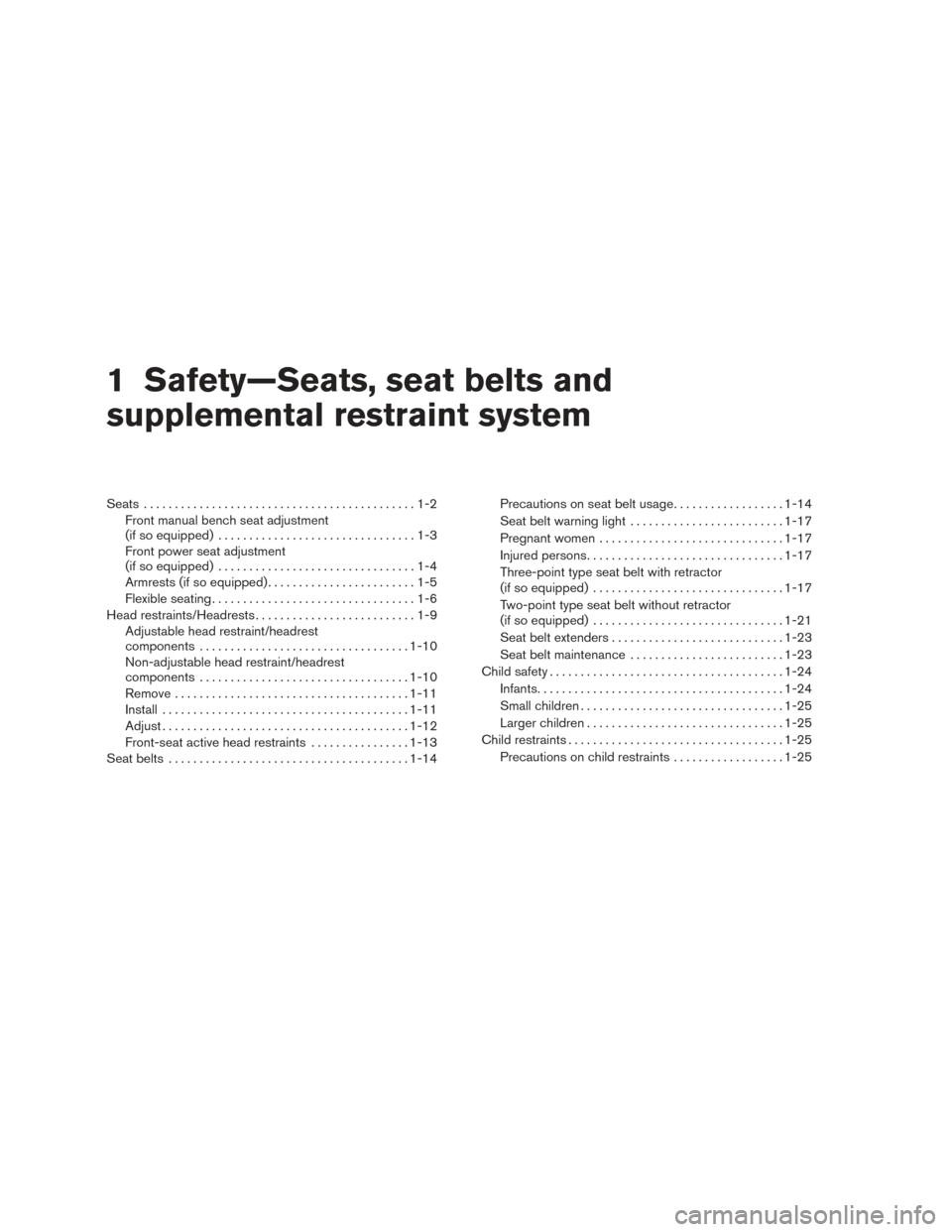
1 Safety—Seats, seat belts and
supplemental restraint system
Seats............................................1-2
Front manual bench seat adjustment
(if so equipped) ................................1-3
Front power seat adjustment
(if so equipped) ................................1-4
Armrests (if so equipped) ........................1-5
Flexible seating .................................1-6
Head restraints/Headrests ..........................1-9
Adjustable head restraint/headrest
components .................................. 1-10
Non-adjustable head restraint/headrest
components .................................. 1-10
Remove ...................................... 1-11
Install ........................................ 1-11
Adjust ........................................ 1-12
Front-seat active head restraints ................1-13
Seat belts ....................................... 1-14Precautions on seat belt usage
..................1-14
Seat belt warning light ......................... 1-17
Pregnant women .............................. 1-17
Injured persons ................................ 1-17
Three-point type seat belt with retractor
(if so equipped) ............................... 1-17
Two-point type seat belt without retractor
(if so equipped) ............................... 1-21
Seat belt extenders ............................ 1-23
Seat belt maintenance ......................... 1-23
Child safety ...................................... 1-24
Infants ........................................ 1-24
Small children ................................. 1-25
Larger children ................................ 1-25
Child restraints ................................... 1-25
Precautions on child restraints ..................1-25
Page 28 of 457
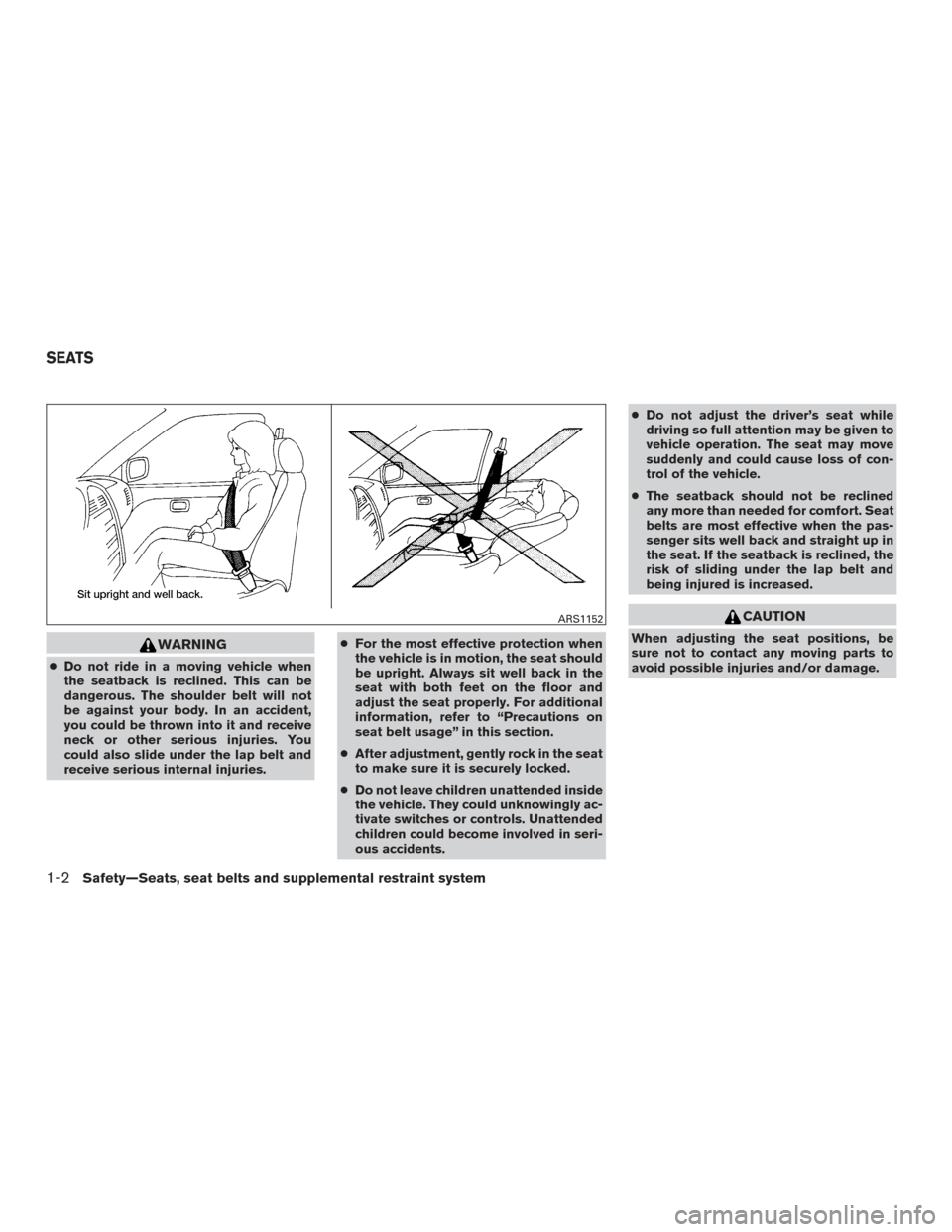
WARNING
●Do not ride in a moving vehicle when
the seatback is reclined. This can be
dangerous. The shoulder belt will not
be against your body. In an accident,
you could be thrown into it and receive
neck or other serious injuries. You
could also slide under the lap belt and
receive serious internal injuries. ●
For the most effective protection when
the vehicle is in motion, the seat should
be upright. Always sit well back in the
seat with both feet on the floor and
adjust the seat properly. For additional
information, refer to “Precautions on
seat belt usage” in this section.
● After adjustment, gently rock in the seat
to make sure it is securely locked.
● Do not leave children unattended inside
the vehicle. They could unknowingly ac-
tivate switches or controls. Unattended
children could become involved in seri-
ous accidents. ●
Do not adjust the driver’s seat while
driving so full attention may be given to
vehicle operation. The seat may move
suddenly and could cause loss of con-
trol of the vehicle.
● The seatback should not be reclined
any more than needed for comfort. Seat
belts are most effective when the pas-
senger sits well back and straight up in
the seat. If the seatback is reclined, the
risk of sliding under the lap belt and
being injured is increased.
CAUTION
When adjusting the seat positions, be
sure not to contact any moving parts to
avoid possible injuries and/or damage.
ARS1152
SEATS
1-2Safety—Seats, seat belts and supplemental restraint system
Page 29 of 457
FRONT MANUAL BENCH SEAT
ADJUSTMENT (if so equipped)
Forward and backward
Pull the lever up and hold it while you slide the
seat forward or backward to the desired position.
Release the lever to lock the seat in position.
Reclining
To recline the seatback, pull the lever up and lean
back. To bring the seatback forward, pull the lever
up and lean your body forward. Release the lever
to lock the seatback in position.
The reclining feature allows adjustment of the
seatback for occupants of different sizes for
added comfort and to help obtain proper seat
belt fit. For additional information, refer to “Pre-
cautions on seat belt usage” in this section. Also,
the seatback can be reclined to allow occupants
to rest when the vehicle is stopped and the shift
lever is in P (Park) .
LRS2575LRS0427
Safety—Seats, seat belts and supplemental restraint system1-3
Page 30 of 457
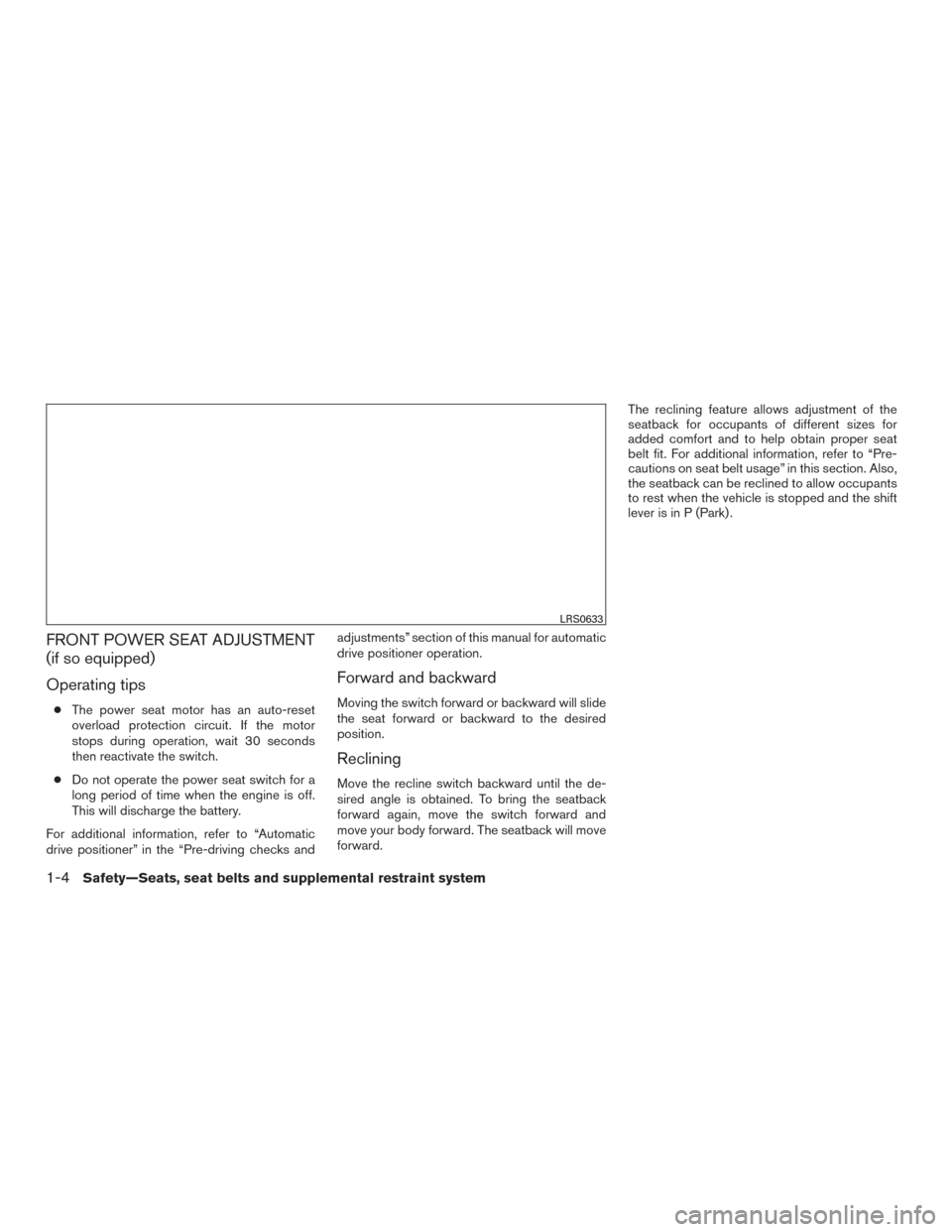
FRONT POWER SEAT ADJUSTMENT
(if so equipped)
Operating tips
●The power seat motor has an auto-reset
overload protection circuit. If the motor
stops during operation, wait 30 seconds
then reactivate the switch.
● Do not operate the power seat switch for a
long period of time when the engine is off.
This will discharge the battery.
For additional information, refer to “Automatic
drive positioner” in the “Pre-driving checks and adjustments” section of this manual for automatic
drive positioner operation.
Forward and backward
Moving the switch forward or backward will slide
the seat forward or backward to the desired
position.
Reclining
Move the recline switch backward until the de-
sired angle is obtained. To bring the seatback
forward again, move the switch forward and
move your body forward. The seatback will move
forward.The reclining feature allows adjustment of the
seatback for occupants of different sizes for
added comfort and to help obtain proper seat
belt fit. For additional information, refer to “Pre-
cautions on seat belt usage” in this section. Also,
the seatback can be reclined to allow occupants
to rest when the vehicle is stopped and the shift
lever is in P (Park) .
LRS0633
1-4Safety—Seats, seat belts and supplemental restraint system
Page 35 of 457
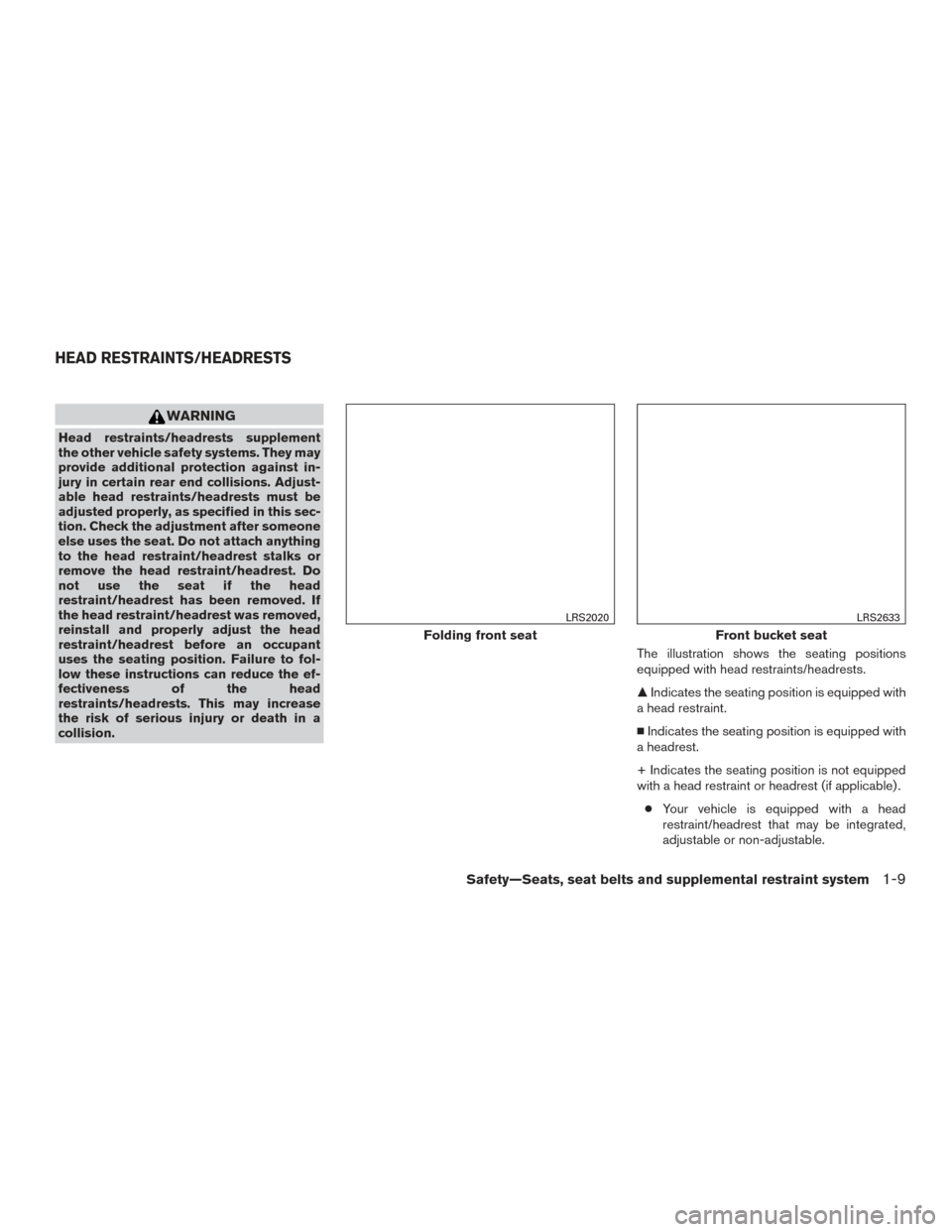
WARNING
Head restraints/headrests supplement
the other vehicle safety systems. They may
provide additional protection against in-
jury in certain rear end collisions. Adjust-
able head restraints/headrests must be
adjusted properly, as specified in this sec-
tion. Check the adjustment after someone
else uses the seat. Do not attach anything
to the head restraint/headrest stalks or
remove the head restraint/headrest. Do
not use the seat if the head
restraint/headrest has been removed. If
the head restraint/headrest was removed,
reinstall and properly adjust the head
restraint/headrest before an occupant
uses the seating position. Failure to fol-
low these instructions can reduce the ef-
fectiveness of the head
restraints/headrests. This may increase
the risk of serious injury or death in a
collision.The illustration shows the seating positions
equipped with head restraints/headrests.
�
Indicates the seating position is equipped with
a head restraint.
� Indicates the seating position is equipped with
a headrest.
+ Indicates the seating position is not equipped
with a head restraint or headrest (if applicable) .
● Your vehicle is equipped with a head
restraint/headrest that may be integrated,
adjustable or non-adjustable.
Folding front seat
LRS2020
Front bucket seat
LRS2633
HEAD RESTRAINTS/HEADRESTS
Safety—Seats, seat belts and supplemental restraint system1-9
Page 36 of 457
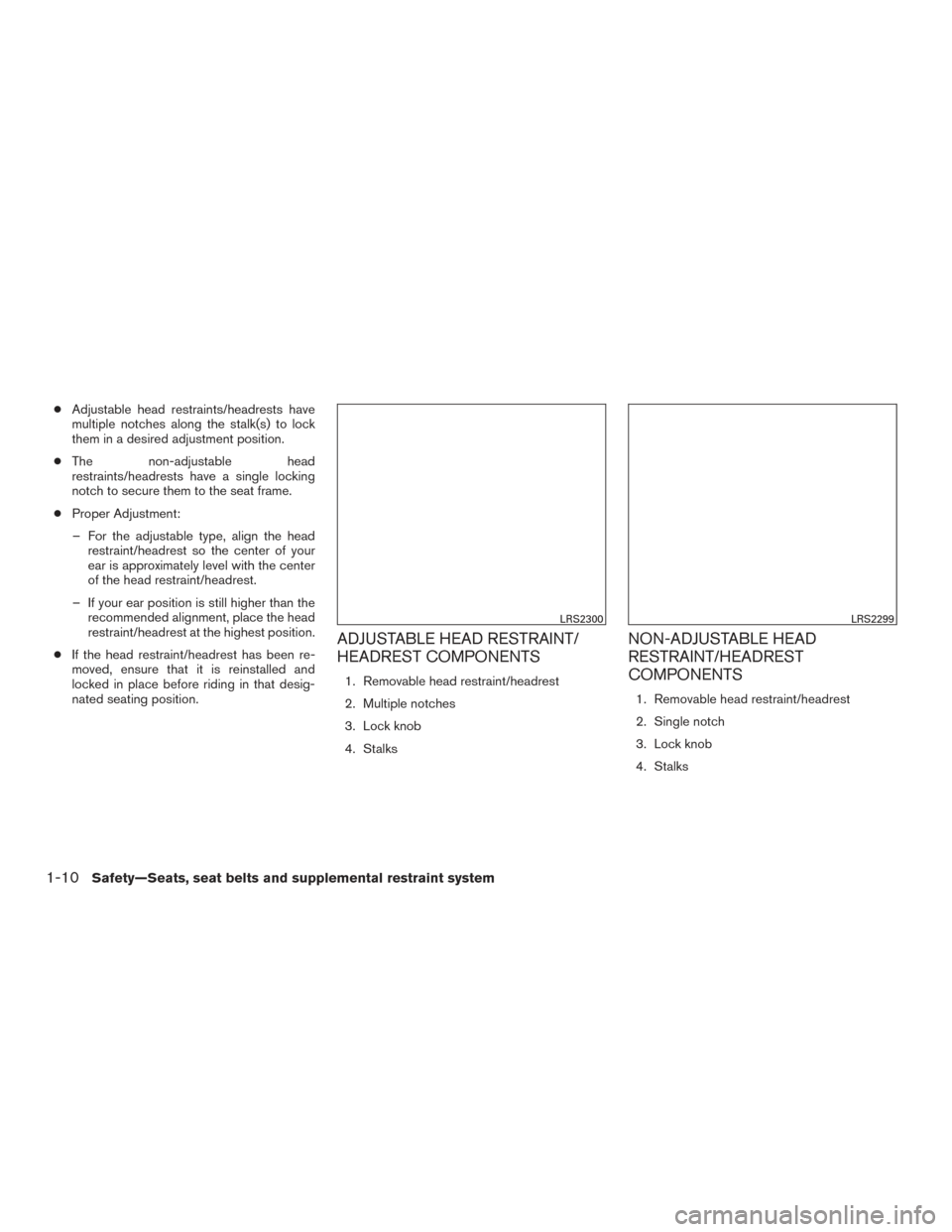
●Adjustable head restraints/headrests have
multiple notches along the stalk(s) to lock
them in a desired adjustment position.
● The non-adjustable head
restraints/headrests have a single locking
notch to secure them to the seat frame.
● Proper Adjustment:
– For the adjustable type, align the head restraint/headrest so the center of your
ear is approximately level with the center
of the head restraint/headrest.
– If your ear position is still higher than the recommended alignment, place the head
restraint/headrest at the highest position.
● If the head restraint/headrest has been re-
moved, ensure that it is reinstalled and
locked in place before riding in that desig-
nated seating position.
ADJUSTABLE HEAD RESTRAINT/
HEADREST COMPONENTS
1. Removable head restraint/headrest
2. Multiple notches
3. Lock knob
4. Stalks
NON-ADJUSTABLE HEAD
RESTRAINT/HEADREST
COMPONENTS
1. Removable head restraint/headrest
2. Single notch
3. Lock knob
4. Stalks
LRS2300LRS2299
1-10Safety—Seats, seat belts and supplemental restraint system